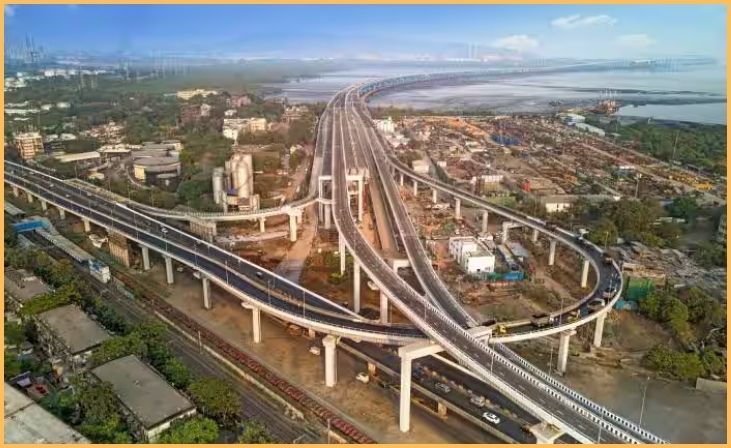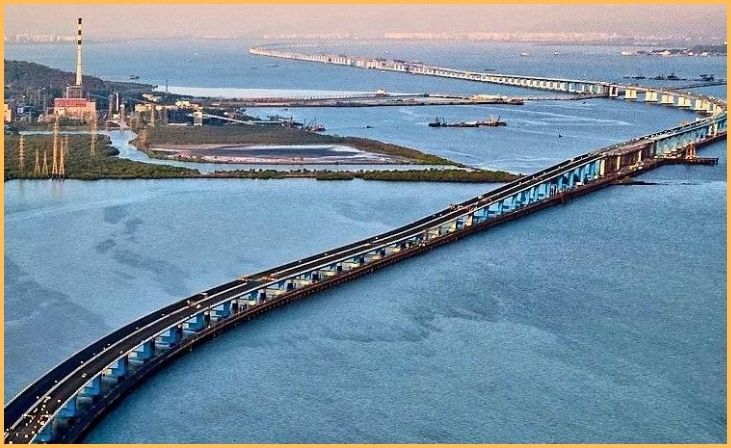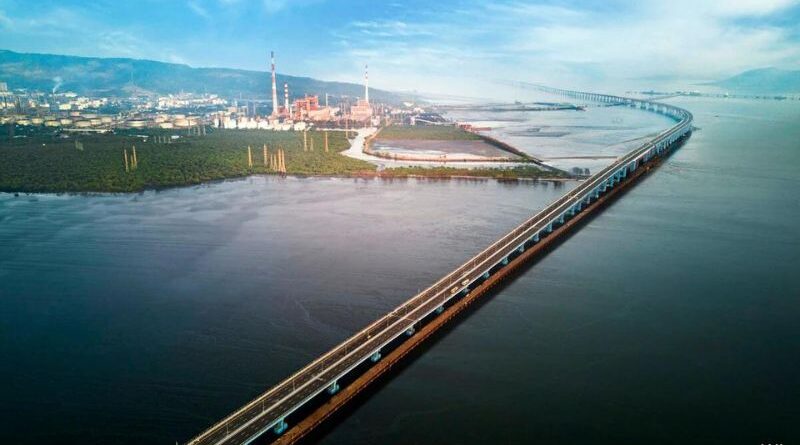The Atal Setu, also known as the Mumbai Trans Harbour Sealink (MTHL), is India’s longest sea bridge. Spanning a length of 22 kilometers, this six-lane bridge connects Sewri in Mumbai to the Nhava Sheva area in Raigad district. The bridge is set to open to traffic on January 12, with its official inauguration by Prime Minister Narendra Modi.
The Atal Setu is a significant infrastructure project that aims to improve connectivity and reduce travel time. Currently, the journey between these two points takes around two hours, but with the bridge, it will be reduced to approximately 15-20 minutes. This development is expected to have a positive impact on commuting and transportation in the region.
The bridge has been named Atal Setu in honor of the late former Prime Minister Atal Bihari Vajpayee, who was known for his vision and leadership. It is a testament to his contributions to the nation.
The construction of the Atal Setu began in December 2016, with the foundation stone laid by Prime Minister Modi. The bridge is a remarkable engineering feat, with a 16.5-kilometer sea link and approximately 5.5 kilometers on land. It is designed to withstand earthquakes of up to 6.5 magnitudes on the Richter scale, incorporating earthquake-resistant technology.
The Atal Setu is expected to provide faster connectivity to Mumbai International Airport and Navi Mumbai International Airport. Additionally, it will reduce travel time from Mumbai to Pune, Goa, and South India, benefiting both commuters and tourists.
Amazing Facts to Know about Atal Setu Sea Bridge
Behold the Atal Setu, a colossal engineering marvel stretching across the Mumbai coast, and India’s crown jewel when it comes to sea bridges. Here are 8 captivating facts about this awe-inspiring structure:
A Monumental Span
Stretching an impressive 21.8 kilometers (13.5 miles), Atal Setu proudly claims the title of India’s longest sea bridge, standing as a testament to engineering excellence. The sheer scale of this architectural marvel is enough to evoke awe and leave onlookers speechless. Connecting distant points across the sea, Atal Setu represents not only a feat of infrastructure but also a symbol of connectivity and progress.
With its grand expanse, the bridge offers not just a physical link but a visual spectacle, showcasing the ingenuity and ambition of modern engineering in India. It stands as a remarkable structure that spans the sea, providing not only transportation convenience but also a breathtaking experience for those fortunate enough to witness its monumental presence.
Quick Link: Top 7 Hindi Crime Thrillers Awaited On Netflix Prime Video And Other OTT In 2024
Connecting Hearts and Cities

The magnificent Atal Setu serves as a seamless link, connecting Sewri in Mumbai to Nhava Sheva in Raigad district with a grandeur that significantly transforms the region’s transportation landscape. This engineering marvel dramatically slashes travel time between these key locations, compressing a once 2-hour journey to a mere 20 minutes. The bridge not only enhances connectivity but also facilitates efficient and expedited movement of goods and people.
Its strategic location strategically supports economic activities, fostering development in both urban and rural areas it connects. Beyond its practical implications, the Atal Setu stands as a symbol of progress, embodying the commitment to modern infrastructure that propels India into a new era of connectivity and accessibility.
A Lifeline for Mumbai’s Growth
Atal Setu transcends its role as a mere bridge, emerging as a transformative force for Mumbai’s infrastructure. Beyond its architectural prowess, the bridge acts as a pivotal solution to traffic congestion, providing a streamlined and efficient route for commuters. Its strategic location significantly enhances connectivity to key hubs like the Navi Mumbai International Airport and Jawaharlal Nehru Port, catalyzing economic activities.
This game-changing structure unlocks immense potential for the region, fostering economic growth, job creation, and attracting investments. As a vital artery in Mumbai’s transportation network, the Atal Setu not only symbolizes progress but actively contributes to the development and prosperity of the entire metropolitan area.
An Engineering Feat

The construction of the colossal Atal Setu was a formidable undertaking that spanned 7 years, involving the dedicated efforts of over 5000 workers. The mammoth structure, brought to life through meticulous planning and execution, required a staggering 1.77 lakh metric tons of steel. Every component of the bridge was carefully designed to withstand the forces of nature, including strong winds, monsoon storms, and earthquakes.
This emphasis on resilience ensures the longevity and safety of Atal Setu, making it not just a remarkable engineering feat but a testament to human ingenuity and commitment to building infrastructure that stands the test of time and adverse conditions.
Sustainability Woven In
The construction of Atal Setu was carried out with a commitment to environmental preservation. Noise barriers were strategically implemented to shield sensitive stretches, mitigating the impact of construction activities on local ecosystems. Adhering to stringent ecological guidelines, the project prioritized minimizing any adverse effects on the marine ecosystem. This environmentally conscious approach underscores the balance between infrastructure development and ecological sustainability.
Atal Setu stands as a testament to responsible engineering, ensuring that progress does not come at the expense of the environment. By integrating eco-friendly practices, the bridge exemplifies a harmonious coexistence between human development and the preservation of the natural world.
A Bridge with a View
Traversing Atal Setu transcends a mere journey; it unfolds as an enchanting experience. The bridge offers travelers breathtaking vistas, treating them to panoramic views of the Mumbai coastline that stretch across the vast expanse of the Arabian Sea. As vehicles traverse, the bustling activities of the port add dynamism to the scenery, creating a mesmerizing tapestry of urban and maritime life.
The journey becomes a visual spectacle, where the architectural marvel of the bridge is complemented by the lively backdrop of port operations and the serene beauty of the ocean. Crossing Atal Setu becomes a sensory journey, inviting travelers to immerse themselves in the dynamic sights of Mumbai’s coastal charm while navigating the expansive views of the Arabian Sea.
A Tribute to a Visionary

Atal Setu carries the distinguished name of former Prime Minister Atal Bihari Vajpayee, a visionary leader whose commitment to a connected India served as the driving force behind this ambitious project. The bridge stands as a tangible tribute to Vajpayee’s foresight and dedication to transforming India’s infrastructure landscape. Named in his honor, Atal Setu symbolizes not only a physical link but also the realization of a dream for enhanced connectivity. Vajpayee’s vision laid the foundation for this monumental undertaking, showcasing the transformative power of leadership in shaping the nation’s progress.
The bridge serves as a living testament to the enduring legacy of a leader whose vision continues to connect people and regions, fostering unity and progress across the vast expanse of the country.
Also Read: The 10 best desserts to make in an air fryer
A Beacon of Hope
Atal Setu stands as a remarkable testament to India’s engineering prowess and indomitable spirit. This monumental structure represents more than just a bridge; it is a symbol of the nation’s progress, exemplifying the capability to undertake and complete complex engineering feats. Beyond its physical expanse, the bridge signifies connectivity, linking regions and people in a seamless flow of transportation.
It stands as a beacon of a brighter future, reflecting the nation’s commitment to infrastructure development and technological advancement. Atal Setu encapsulates the resilience and determination of the Indian spirit, showcasing the ability to overcome challenges and forge pathways to a more connected and prosperous tomorrow.
Bottom Line
In conclusion, the Atal Setu, India’s longest sea bridge, is set to open to traffic, connecting Sewri in Mumbai to the Nhava Sheva area in Raigad district. This six-lane bridge spans a length of 22 kilometers and aims to improve connectivity and reduce travel time in the region. Named in honor of the late former Prime Minister Atal Bihari Vajpayee, the Atal Setu is a significant infrastructure project that showcases remarkable engineering and earthquake-resistant technology.
With its inauguration, the Atal Setu is expected to provide faster connectivity to Mumbai International Airport and Navi Mumbai International Airport. It will also reduce travel time between Mumbai and other destinations such as Pune, Goa, and South India. This development is set to have a positive impact on commuting, transportation, and tourism in the region.
The Atal Setu stands as a testament to India’s commitment to infrastructure development and improving ease of mobility. It is a remarkable achievement that will benefit both residents and visitors alike, enhancing connectivity and facilitating economic growth in the region.
FAQs
The Atal Setu, also known as the Mumbai Trans Harbour Sealink (MTHL), spans a length of 22 kilometers, making it India’s longest sea bridge.
The Atal Setu is set to open to traffic on January 12, with its official inauguration by Prime Minister Narendra Modi.
The bridge has been named Atal Setu in honor of the late former Prime Minister Atal Bihari Vajpayee, who was known for his vision and leadership.
The Atal Setu aims to improve connectivity and reduce travel time. It will provide faster access to Mumbai International Airport and Navi Mumbai International Airport, as well as reduce travel time between Mumbai and other destinations such as Pune, Goa, and South India.







